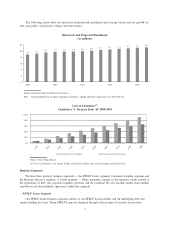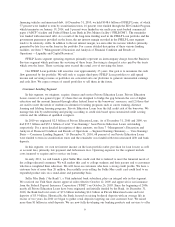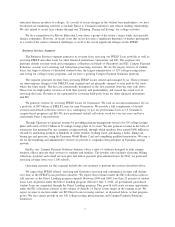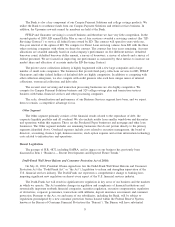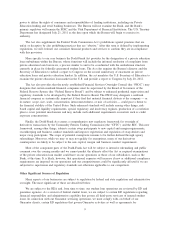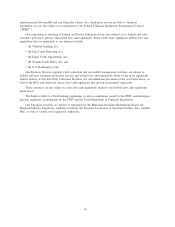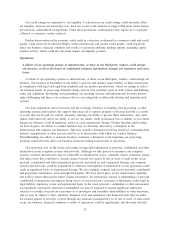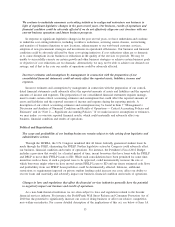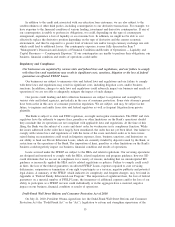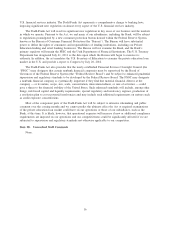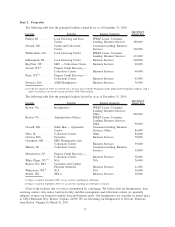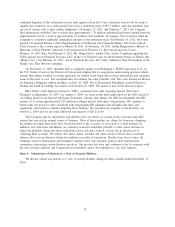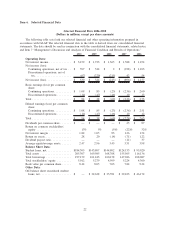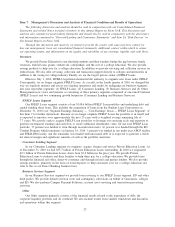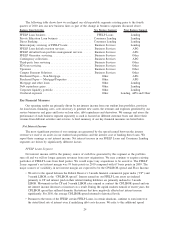Sallie Mae 2010 Annual Report Download - page 16
Download and view the complete annual report
Please find page 16 of the 2010 Sallie Mae annual report below. You can navigate through the pages in the report by either clicking on the pages listed below, or by using the keyword search tool below to find specific information within the annual report.In addition to the credit risk associated with our education loan customers, we are also subject to the
creditworthiness of other third parties, including counterparties to our derivative transactions. For example, we
have exposure to the financial condition of various lending, investment and derivative counterparties. If any of
our counterparties is unable to perform its obligations, we could, depending on the type of counterparty
arrangement, experience a loss of liquidity or an economic loss. In addition, we might not be able to cost
effectively replace the derivative position depending on the type of derivative and the current economic
environment, and thus be exposed to a greater level of interest rate and/or foreign currency exchange rate risk
which could lead to additional losses. Our counterparty exposure is more fully discussed in Item 7
“Management’s Discussion and Analysis of Financial Condition and Results of Operations — Liquidity and
Capital Resources — Counterparty Exposure.” If our counterparties are unable to perform their obligations, our
business, financial condition and results of operations could suffer.
Regulatory and Compliance.
Our businesses are regulated by various state and federal laws and regulations, and our failure to comply
with these laws and regulations may result in significant costs, sanctions, litigation or the loss of federal
guarantees on affected FFELP Loans.
Our businesses are subject to numerous state and federal laws and regulations and our failure to comply
with these laws and regulations may result in significant costs, including litigation costs, and/or business
sanctions. In addition, changes to such laws and regulations could adversely impact our business and results of
operations if we are not able to adequately mitigate the impact of such changes.
Our private credit lending and debt collection businesses are subject to regulation and oversight by
various state and federal agencies, particularly in the area of consumer protection. Some state attorneys general
have been active in this area of consumer protection regulation. We are subject, and may be subject in the
future, to inquiries and audits from state and federal regulators as well as frequent litigation from private
plaintiffs.
The Bank is subject to state and FDIC regulation, oversight and regular examination. The FDIC and state
regulators have the authority to impose fines, penalties or other limitations on the Bank’s operations should
they conclude that its operations are not compliant with applicable laws and regulations. At the time of this
filing, the Bank was the subject of a cease and desist order for weaknesses in its compliance function. While
the issues addressed in the order have largely been remediated, the order has not yet been lifted. Our failure to
comply with various laws and regulations or with the terms of the cease and desist order or to have issues
raised during an examination could result in litigation expenses, fines, business sanctions, and limitations on
our ability to fund our Private Education Loans, which are currently funded by deposits raised by the Bank, or
restrictions on the operations of the Bank. The imposition of fines, penalties or other limitations on the Bank’s
business could negatively impact our business, financial condition and results of operations.
Loans serviced under the FFELP are subject to the HEA and related regulations. Our servicing operations
are designed and monitored to comply with the HEA, related regulations and program guidance; however ED
could determine that we are not in compliance for a variety of reasons, including that we misinterpreted ED
guidance or incorrectly applied the HEA and its related regulations or policies. Failure to comply could result
in fines, the loss of the federal guarantees on affected FFELP Loans, expenses required to cure servicing
deficiencies, suspension or termination of our right to participate as a servicer, negative publicity and potential
legal claims. A summary of the FFELP, which indicates its complexity and frequent changes, may be found in
Appendix A “Federal Family Education Loan Program.” The imposition of significant fines, the loss of federal
guarantees on a material number of FFELP Loans, the incurrence of additional expenses and/or the loss of our
ability to participate as a FFELP servicer could individually or in the aggregate have a material, negative
impact on our business, financial condition or results of operations.
Dodd-Frank Wall Street Reform and Consumer Protection Act of 2010
On July 21, 2010, President Obama signed into law the Dodd-Frank Wall Street Reform and Consumer
Protection Act (the “Dodd-Frank Act” or the “Act”), legislation to reform and strengthen supervision of the
15


